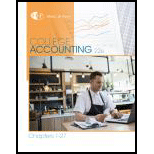
College Accounting, Chapters 1-27 (New in Accounting from Heintz and Parry)
22nd Edition
ISBN: 9781305666160
Author: James A. Heintz, Robert W. Parry
Publisher: Cengage Learning
expand_more
expand_more
format_list_bulleted
Concept explainers
Question
Chapter 16, Problem 4MC
To determine
Find the correct amount that should be entered for the
Expert Solution & Answer
Trending nowThis is a popular solution!

Students have asked these similar questions
I don't need ai answer general accounting question
Need help with this question solution general accounting
Calculate the cost per equivalent unit of conversion
Chapter 16 Solutions
College Accounting, Chapters 1-27 (New in Accounting from Heintz and Parry)
Ch. 16 - There are two methods of accounting for...Ch. 16 - The matching principle states that debits should...Ch. 16 - Using the percentage of sales method, the balance...Ch. 16 - When an account is written off under the allowance...Ch. 16 - Each time an account is written off under the...Ch. 16 - The dollar difference between Accounts Receivable...Ch. 16 - A business has an ending balance in Accounts...Ch. 16 - A business has an ending balance in Accounts...Ch. 16 - Prob. 4MCCh. 16 - Under the allowance method, when an account is...
Ch. 16 - Prob. 1CECh. 16 - Tonis Tech Shop has total credit sales for the...Ch. 16 - Fionas Pharmacy uses the direct write-off method...Ch. 16 - Prob. 1RQCh. 16 - Prob. 2RQCh. 16 - Prob. 3RQCh. 16 - Prob. 4RQCh. 16 - Prob. 5RQCh. 16 - Prob. 6RQCh. 16 - Prob. 7RQCh. 16 - Under the allowance method, what journal entries...Ch. 16 - Prob. 9RQCh. 16 - Prob. 10RQCh. 16 - CALCULATION OF NET REALIZABLE VALUE L. R. Updike...Ch. 16 - UNCOLLECTIBLE ACCOUNTSPERCENTAGE OF SALES Rossins...Ch. 16 - UNCOLLECTIBLE ACCOUNTSPERCENTAGE OF RECEIVABLES...Ch. 16 - COLLECTION OF ACCOUNTS WRITTEN OFFALLOWANCE METHOD...Ch. 16 - UNCOLLECTIBLE ACCOUNTSPERCENTAGE OF SALES AND...Ch. 16 - DIRECT WRITE-OFF METHOD Maria Rivera, owner of...Ch. 16 - COLLECTION OF ACCOUNT WRITTEN OFFDIRECT WRITE-OFF...Ch. 16 - UNCOLLECTIBLE ACCOUNTSALLOWANCE METHOD Pyle...Ch. 16 - UNCOLLECTIBLE ACCOUNTSPERCENTAGE OF SALES AND...Ch. 16 - AGING ACCOUNTS RECEIVABLE An analysis of the...Ch. 16 - DIRECT WRITE-OFF METHOD Williams Hendricks...Ch. 16 - CALCULATION OF NET REALIZABLE VALUE Mary Martin...Ch. 16 - UNCOLLECTIBLE ACCOUNTS-PERCENTAGE OF SALES Nicoles...Ch. 16 - UNCOLLECTIBLE ACCOUNTS-PERCENTAGE OF RECEIVABLES...Ch. 16 - COLLECTION OF ACCOUNT WRITTEN OFFALLOWANCE METHOD...Ch. 16 - UNCOLLECTIBLE ACCOUNTSPERCENTAGE OF SALES AND...Ch. 16 - DIRECT WRITE-OFF METHOD Brent Mussellman, owner of...Ch. 16 - COLLECTION OF ACCOUNT WRITTEN OFFDIRECT WRITE-OFF...Ch. 16 - UNCOLLECTIBLE ACCOUNTSALLOWANCE METHOD Lewis...Ch. 16 - UNCOLLECTIBLE ACCOUNTSPERCENTAGE OF SALES AND...Ch. 16 - AGING ACCOUNTS RECEIVABLE An analysis of the...Ch. 16 - DIRECT WRITE-OFF METHOD Lee and Chen Distributors...Ch. 16 - Sam and Robert are identical twins. They opened...Ch. 16 - Martel Co. has 320,000 in Accounts Receivable on...Ch. 16 - Prob. 2CPCh. 16 - At the end of 20-3, Martel Co. had 410,000 in...
Knowledge Booster
Learn more about
Need a deep-dive on the concept behind this application? Look no further. Learn more about this topic, accounting and related others by exploring similar questions and additional content below.Similar questions
arrow_back_ios
SEE MORE QUESTIONS
arrow_forward_ios
Recommended textbooks for you
 Financial AccountingAccountingISBN:9781305088436Author:Carl Warren, Jim Reeve, Jonathan DuchacPublisher:Cengage Learning
Financial AccountingAccountingISBN:9781305088436Author:Carl Warren, Jim Reeve, Jonathan DuchacPublisher:Cengage Learning Intermediate Accounting: Reporting And AnalysisAccountingISBN:9781337788281Author:James M. Wahlen, Jefferson P. Jones, Donald PagachPublisher:Cengage LearningPrinciples of Accounting Volume 1AccountingISBN:9781947172685Author:OpenStaxPublisher:OpenStax College
Intermediate Accounting: Reporting And AnalysisAccountingISBN:9781337788281Author:James M. Wahlen, Jefferson P. Jones, Donald PagachPublisher:Cengage LearningPrinciples of Accounting Volume 1AccountingISBN:9781947172685Author:OpenStaxPublisher:OpenStax College College Accounting, Chapters 1-27AccountingISBN:9781337794756Author:HEINTZ, James A.Publisher:Cengage Learning,
College Accounting, Chapters 1-27AccountingISBN:9781337794756Author:HEINTZ, James A.Publisher:Cengage Learning,

Financial Accounting
Accounting
ISBN:9781305088436
Author:Carl Warren, Jim Reeve, Jonathan Duchac
Publisher:Cengage Learning

Intermediate Accounting: Reporting And Analysis
Accounting
ISBN:9781337788281
Author:James M. Wahlen, Jefferson P. Jones, Donald Pagach
Publisher:Cengage Learning

Principles of Accounting Volume 1
Accounting
ISBN:9781947172685
Author:OpenStax
Publisher:OpenStax College

College Accounting, Chapters 1-27
Accounting
ISBN:9781337794756
Author:HEINTZ, James A.
Publisher:Cengage Learning,
Accounts Receivable and Accounts Payable; Author: The Finance Storyteller;https://www.youtube.com/watch?v=x_aUWbQa878;License: Standard Youtube License